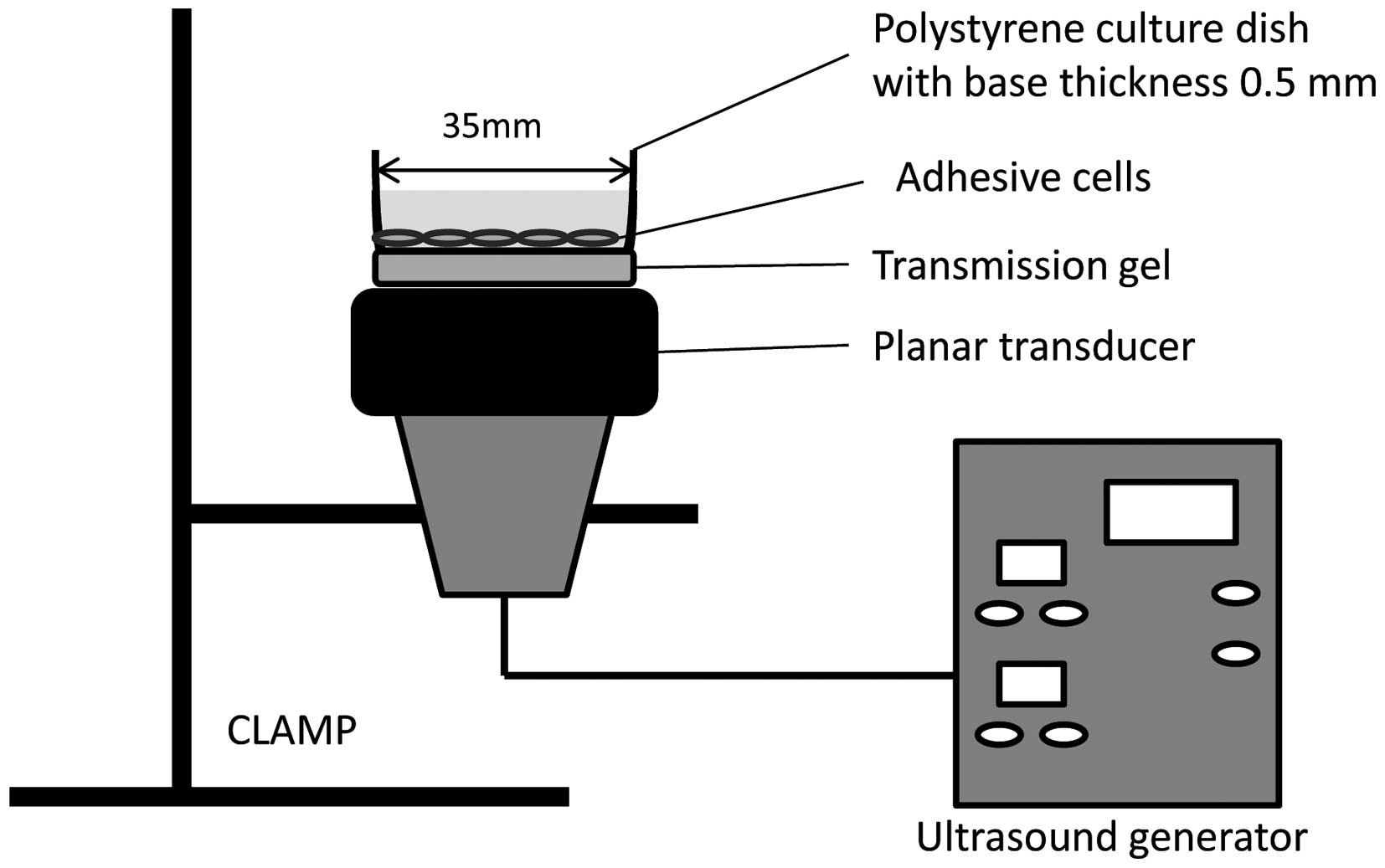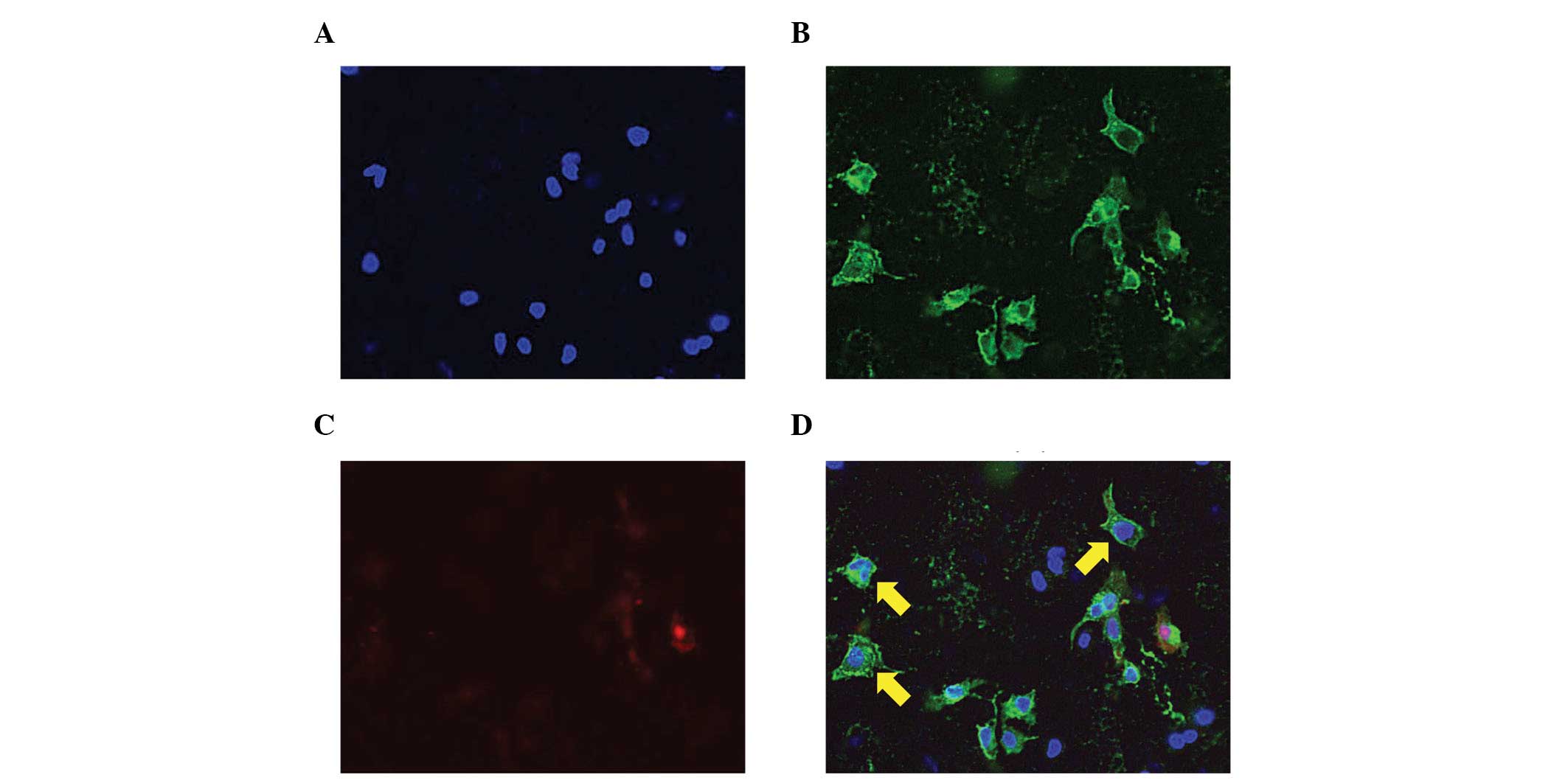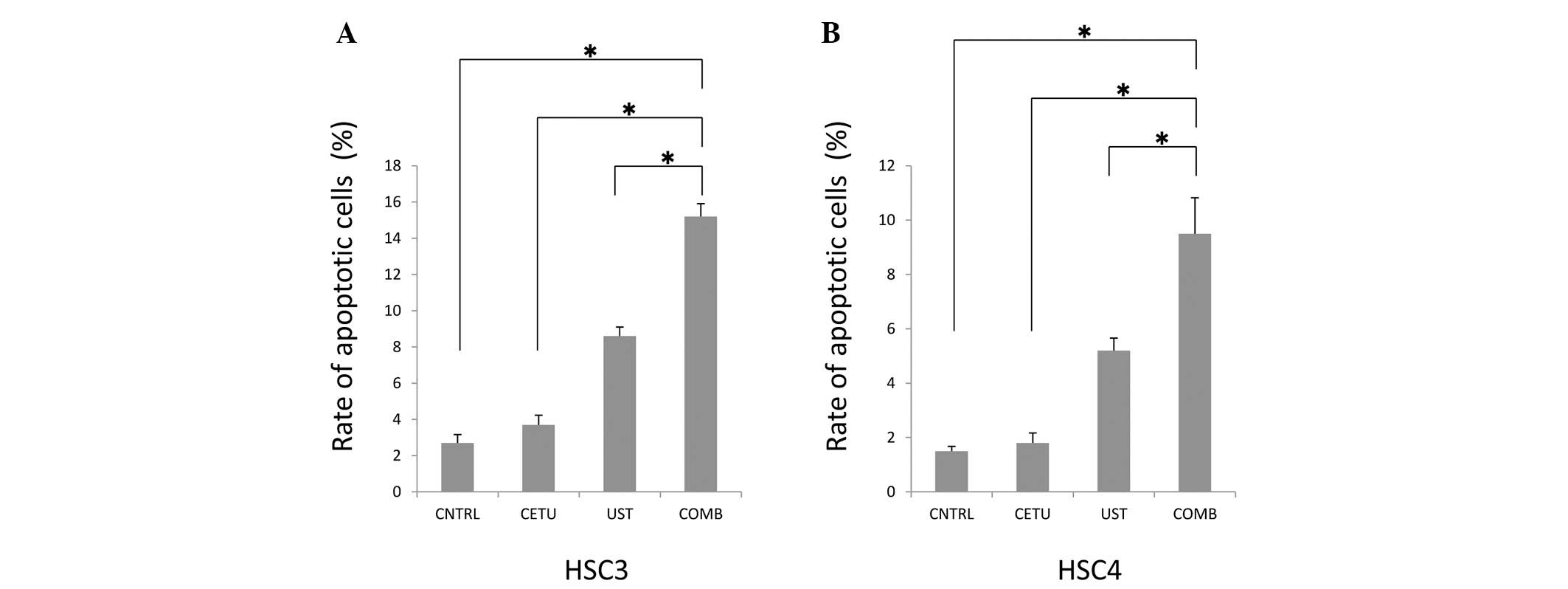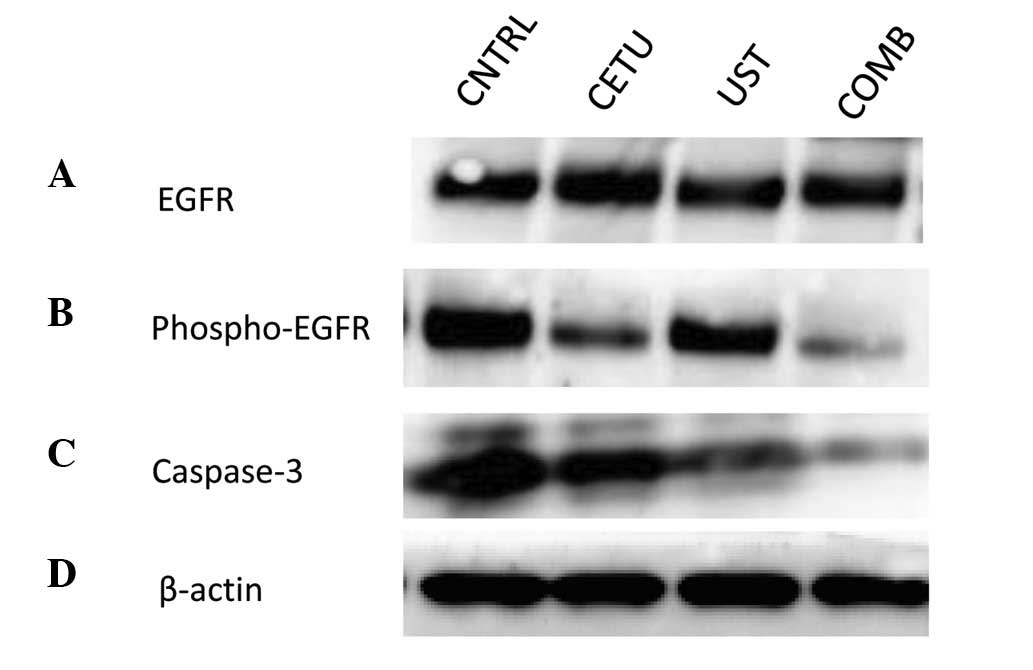|
1
|
Fulda S and Debatin KM: Apoptosis pathways
in neuroblastoma therapy. Cancer Lett. 197:131–135. 2003.
View Article : Google Scholar
|
|
2
|
Mandal D, Mazumder A, Das P, Kundu M and
Basu J: Fas-, caspase 8-, and caspase 3-dependent signaling
regulates the activity of the aminophospholipid translocase and
phosphatidylserine externalization in human erythrocytes. J Biol
Chem. 280:39460–39467. 2005. View Article : Google Scholar
|
|
3
|
Ashush H, Rozenszajn LA, Blass M, et al:
Apoptosis induction of human myeloid leukemic cells by ultrasound
exposure. Cancer Res. 60:1014–1020. 2000.PubMed/NCBI
|
|
4
|
Lagneaux L, de Meulenaer EC, Delforge A,
et al: Ultrasonic low-energy treatment: a novel approach to induce
apoptosis in human leukemic cells. Exp Hematol. 30:1293–1301. 2002.
View Article : Google Scholar : PubMed/NCBI
|
|
5
|
Honda H, Zhao QL and Kondo T: Effects of
dissolved gases and an echo contrast agent on apoptosis induced by
ultrasound and its mechanism via the mitochondria-caspase pathway.
Ultrasound Med Biol. 28:673–682. 2002. View Article : Google Scholar : PubMed/NCBI
|
|
6
|
Feril LB Jr, Kondo T, Zhao QL and Ogawa R:
Enhancement of hyperthermia-induced apoptosis by non-thermal
effects of ultrasound. Cancer Lett. 178:63–70. 2002. View Article : Google Scholar : PubMed/NCBI
|
|
7
|
Feril LB Jr, Kondo T, Zhao QL, et al:
Enhancement of ultrasound-induced apoptosis and cell lysis by
echo-contrast agents. Ultrasound Med Biol. 29:331–337. 2003.
View Article : Google Scholar : PubMed/NCBI
|
|
8
|
Abdollahi A, Domhan S, Jenne JW, et al:
Apoptosis signals in lymphoblasts induced by focused ultrasound.
Faseb J. 18:1413–1414. 2004.PubMed/NCBI
|
|
9
|
Huber PE, Jenne JW, Rastert R, et al: A
new noninvasive approach in breast cancer therapy using magnetic
resonance imaging-guided focused ultrasound surgery. Cancer Res.
61:8441–8447. 2001.PubMed/NCBI
|
|
10
|
Blana A, Walter B, Rogenhofer S and
Wieland WF: High-intensity focused ultrasound for the treatment of
localized prostate cancer: 5-year experience. Urology. 63:297–300.
2004.PubMed/NCBI
|
|
11
|
Larkin JO, Casey GD, Tangney M, et al:
Effective tumor treatment using optimized ultrasound-mediated
delivery of bleomycin. Ultrasound Med Biol. 34:406–413. 2008.
View Article : Google Scholar : PubMed/NCBI
|
|
12
|
Feril LB Jr, Kondo T, Cui ZG, et al:
Apoptosis induced by the sonomechanical effects of low intensity
pulsed ultrasound in a human leukemia cell line. Cancer Lett.
221:145–152. 2005. View Article : Google Scholar : PubMed/NCBI
|
|
13
|
Feng Y, Tian ZM, Wan MX and Zheng ZB: Low
intensity ultrasound-induced apoptosis in human gastric carcinoma
cells. World J Gastroenterol. 14:4873–4879. 2008. View Article : Google Scholar : PubMed/NCBI
|
|
14
|
Lejbkowicz F and Salzberg S: Distinct
sensitivity of normal and malignant cells to ultrasound in vitro.
Environ Health Perspect. 105(Suppl 6): 1575–1578. 1997. View Article : Google Scholar : PubMed/NCBI
|
|
15
|
Yoshida T, Kondo T, Ogawa R, et al:
Combination of doxorubicin and low-intensity ultrasound causes a
synergistic enhancement in cell killing and an additive enhancement
in apoptosis induction in human lymphoma U937 cells. Cancer
Chemother Pharmacol. 61:559–567. 2008. View Article : Google Scholar : PubMed/NCBI
|
|
16
|
Watanabe Y, Aoi A, Horie S, et al:
Low-intensity ultrasound and microbubbles enhance the antitumor
effect of cisplatin. Cancer Sci. 99:2525–2531. 2008. View Article : Google Scholar : PubMed/NCBI
|
|
17
|
Danno D, Kanno M, Fujimoto S, Feril LB Jr,
Kondo T and Nakamura S: Effects of ultrasound on apoptosis induced
by anti-CD20 antibody in CD20-positive B lymphoma cells. Ultrason
Sonochem. 15:463–471. 2008. View Article : Google Scholar : PubMed/NCBI
|
|
18
|
Mendelsohn J: Blockade of receptors for
growth factors: an anticancer therapy - the fourth annual Joseph H
Burchenal American Association of Cancer Research Clinical Research
Award Lecture. Clin Cancer Res. 6:747–753. 2000.
|
|
19
|
Feril LB Jr and Kondo T: Major factors
involved in the inhibition of ultrasound-induced free radical
production and cell killing by pre-sonication incubation or by high
cell density. Ultrason Sonochem. 12:353–357. 2005. View Article : Google Scholar : PubMed/NCBI
|
|
20
|
Bollag DM and Edelstein SJ: Protein
methods. Wiley-Liss; New York: 1991
|
|
21
|
Hayashi K, Motoyama S, Koyota S, et al:
REG I enhances chemo- and radiosensitivity in squamous cell
esophageal cancer cells. Cancer Sci. 99:2491–2495. 2008. View Article : Google Scholar : PubMed/NCBI
|
|
22
|
Feng Y, Tian Z and Wan M: Bioeffects of
low-intensity ultrasound in vitro: apoptosis, protein profile
alteration, and potential molecular mechanism. J Ultrasound Med.
29:963–974. 2010.PubMed/NCBI
|
|
23
|
Tezel A, Sens A, Tuchscherer J and
Mitragotri S: Frequency dependence of sonophoresis. Pharm Res.
18:1694–1700. 2001. View Article : Google Scholar : PubMed/NCBI
|
|
24
|
Chen WS, Matula TJ and Crum LA: The
disappearance of ultrasound contrast bubbles: observations of
bubble dissolution and cavitation nucleation. Ultrasound Med Biol.
28:793–803. 2002. View Article : Google Scholar : PubMed/NCBI
|
|
25
|
Miller DL and Dou C: Membrane damage
thresholds for 1- to 10-MHz pulsed ultrasound exposure of
phagocytic cells loaded with contrast agent gas bodies in vitro.
Ultrasound Med Biol. 30:973–977. 2004. View Article : Google Scholar : PubMed/NCBI
|
|
26
|
Hallow DM, Mahajan AD, McCutchen TE and
Prausnitz MR: Measurement and correlation of acoustic cavitation
with cellular bioeffects. Ultrasound Med Biol. 32:1111–1122. 2006.
View Article : Google Scholar : PubMed/NCBI
|
|
27
|
Kodama T, Tomita Y, Koshiyama K and
Blomley MJ: Transfection effect of microbubbles on cells in
superposed ultrasound waves and behavior of cavitation bubble.
Ultrasound Med Biol. 32:905–914. 2006. View Article : Google Scholar : PubMed/NCBI
|
|
28
|
Larina IV, Evers BM and Esenaliev RO:
Optimal drug and gene delivery in cancer cells by
ultrasound-induced cavitation. Anticancer Res. 25:149–156.
2005.PubMed/NCBI
|
|
29
|
Honda H, Kondo T, Zhao QL, Feril LB Jr and
Kitagawa H: Role of intracellular calcium ions and reactive oxygen
species in apoptosis induced by ultrasound. Ultrasound Med Biol.
30:683–692. 2004. View Article : Google Scholar : PubMed/NCBI
|
|
30
|
Firestein F, Rozenszajn LA,
Shemesh-Darvish L, Elimelech R, Radnay J and Rosenschein U:
Induction of apoptosis by ultrasound application in human malignant
lymphoid cells: role of mitochondria-caspase pathway activation.
Ann N Y Acad Sci. 1010:163–166. 2003. View Article : Google Scholar : PubMed/NCBI
|
|
31
|
Feril LB Jr, Tsuda Y, Kondo T, et al:
Ultrasound-induced killing of monocytic U937 cells enhanced by
2,2′-azobis(2-amidino-propane) dihydrochloride. Cancer Sci.
95:181–185. 2004.
|
|
32
|
Koshiyama K, Kodama T, Yano T and Fujikawa
S: Structural change in lipid bilayers and water penetration
induced by shock waves: molecular dynamics simulations. Biophys J.
91:2198–2205. 2006. View Article : Google Scholar : PubMed/NCBI
|
|
33
|
Duvshani-Eshet M, Adam D and Machluf M:
The effects of albumin-coated microbubbles in DNA delivery mediated
by therapeutic ultrasound. J Control Release. 112:156–166. 2006.
View Article : Google Scholar : PubMed/NCBI
|
|
34
|
Taniyama Y, Tachibana K, Hiraoka K, et al:
Local delivery of plasmid DNA into rat carotid artery using
ultrasound. Circulation. 105:1233–1239. 2002. View Article : Google Scholar : PubMed/NCBI
|
|
35
|
Kagiya G, Ogawa R, Tabuchi Y, et al:
Expression of heme oxygenase-1 due to intracellular reactive oxygen
species induced by ultrasound. Ultrason Sonochem. 13:388–396. 2006.
View Article : Google Scholar : PubMed/NCBI
|
|
36
|
Yuan J: Molecular control of life and
death. Curr Opin Cell Biol. 7:211–214. 1995. View Article : Google Scholar
|
|
37
|
Majno G and Joris I: Apoptosis, oncosis,
and necrosis. An overview of cell death. Am J Pathol. 146:3–15.
1995.PubMed/NCBI
|
|
38
|
Wyllie AH, Kerr JF and Currie AR: Cell
death: the significance of apoptosis. Int Rev Cytol. 68:251–306.
1980. View Article : Google Scholar
|
|
39
|
Kroemer G, Galluzzi L and Brenner C:
Mitochondrial membrane permeabilization in cell death. Physiol Rev.
87:99–163. 2007. View Article : Google Scholar : PubMed/NCBI
|
|
40
|
Ciardiello F and Tortora G: A novel
approach in the treatment of cancer: targeting the epidermal growth
factor receptor. Clin Cancer Res. 7:2958–2970. 2001.PubMed/NCBI
|
|
41
|
Vermorken JB, Trigo J, Hitt R, et al:
Open-label, uncontrolled, multicenter phase II study to evaluate
the efficacy and toxicity of cetuximab as a single agent in
patients with recurrent and/or metastatic squamous cell carcinoma
of the head and neck who failed to respond to platinum-based
therapy. J Clin Oncol. 25:2171–2177. 2007.
|



















